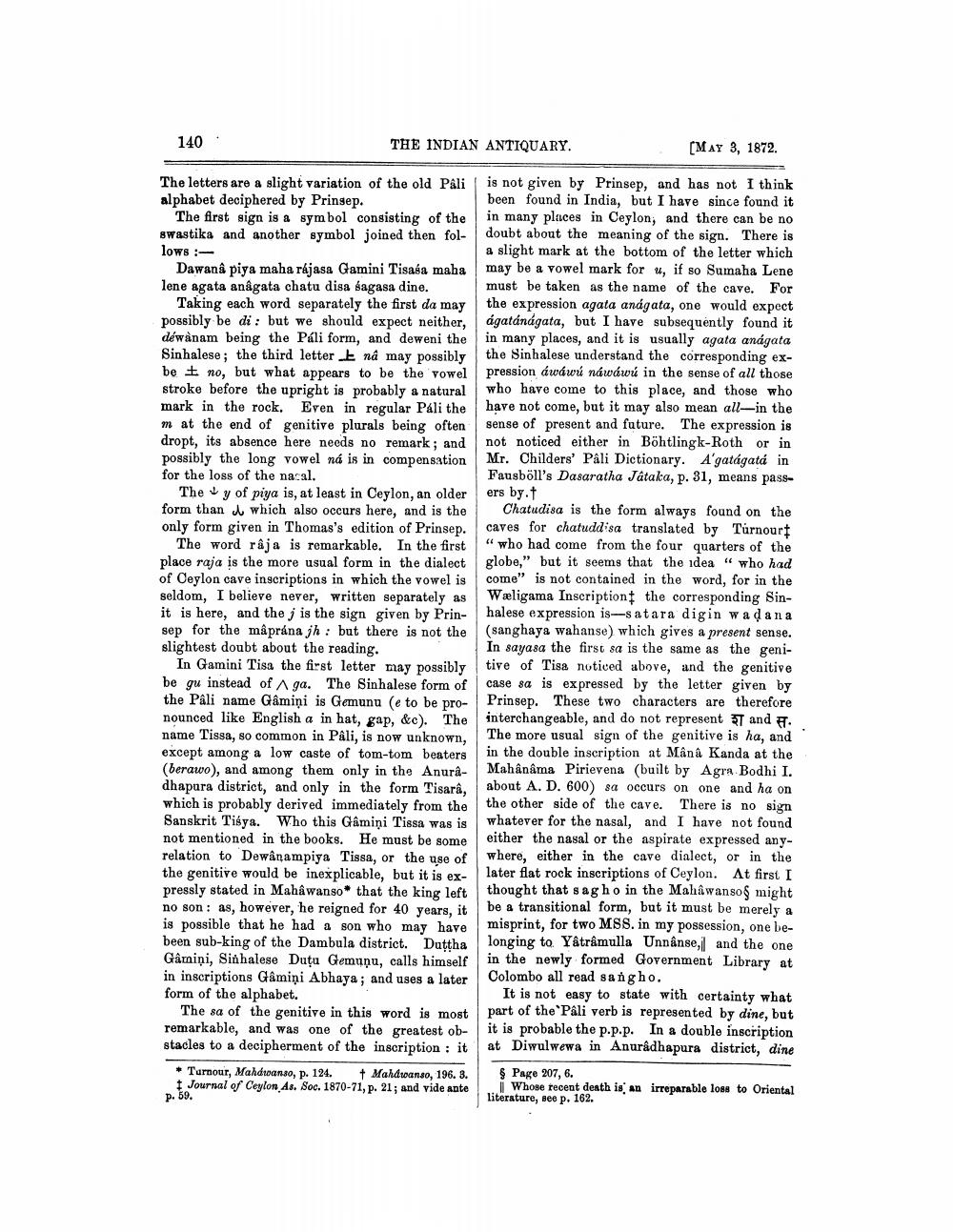________________
140
THE INDIAN ANTIQUARY.
(MAY 3, 1872.
The letters are a slight variation of the old Pali alphabet deciphered by Prinsep.
The first sign is a symbol consisting of the swastika and another symbol joined then follows :
Dawang piya maha rájasa Gamini Tisasa maha lene agata anâgata chatu disa sagasa dine.
Taking each word separately the first da may possibly be di: but we should expect neither, déwanam being the Páli form, and deweni the Sinhalese; the third letter na may possibly be + no, but what appears to be the vowel stroke before the upright is probably a natural mark in the rock. Even in regular Pali the m at the end of genitive plurals being often dropt, its absence here needs no remark; and possibly the long vowel ná is in compensation for the loss of the nasal.
They of piya is, at least in Ceylon, an older form than a which also occurs here, and is the only form given in Thomas's edition of Prinsep.
The word rája is remarkable. In the first place raja is the more usual form in the dialect of Ceylon cave inscriptions in which the vowel is seldom, I believe never, written separately as it is here, and the j is the sign given by Prinsep for the mâprána jh : but there is not the slightest doubt about the reading.
In Gamini Tisa the first letter may possibly be gu instead of ga. The Sinhalese form of the Pali name Gâmiņi is Gemunu (e to be pronounced like English a in hat, gap, &c). The name Tissa, so common in Páli, is now unknown, except among a low caste of tom-tom beaters (berawo), and among them only in the Anuradhapura district, and only in the form Tisara, which is probably derived immediately from the Sanskrit Tisya. Who this Gamini Tissa was is not mentioned in the books. He must be some relation to Dewanampiya Tissa, or the use of the genitive would be inexplicable, but it is expressly stated in Mahawanso that the king left no son: as, however, he reigned for 40 years, it is possible that he had a son who may have been sub-king of the Dambula district. Duttha Gamini, Sinhalese Dutu Gemunu, calls himself in inscriptions Gâmiņi Abhaya; and uses a later form of the alphabet.
The sa of the genitive in this word is most remarkable, and was one of the greatest ob- stacles to a decipherment of the inscription : it
is not given by Prinsep, and has not I think been found in India, but I have since found it in many places in Ceylon; and there can be no doubt about the meaning of the sign. There is a slight mark at the bottom of the letter which may be a vowel mark for u, if so Sumaha Lene must be taken as the name of the cave. For the expression agata anágata, one would expect ágatánágata, but I have subsequently found it in many places, and it is usually agata anágata the Sinhalese understand the corresponding expression áwáwú nawawu in the sense of all those who have come to this place, and those who have not come, but it may also mean all-in the sense of present and future. The expression is not noticed either in Böhtlingk-Roth or in Mr. Childers' Pali Dictionary. A gatágata in Fausböll's Dasaratha Jataka, p. 31, means passers by.
Chatudisa is the form always found on the caves for chatuddisa translated by Túrnourt “who had come from the four quarters of the globe," but it seems that the idea " who had come" is not contained in the word, for in the Waligama Inscriptiont the corresponding Sinhalese expression is--satara digin wadana sanghaya wahanse) which gives a present sense. In sayasa the first sa is the same as the genitive of Tisa noticed above, and the genitive case sa is expressed by the letter given by Prinsep. These two characters are therefore interchangeable, and do not represent 7 and . The more usual sign of the genitive is ha, and in the double inscription at Mânâ Kanda at the Mahânâma Pirievena (built by Agra Bodhi I. about A. D. 600) sa occurs on one and ha on the other side of the cave. There is no sign whatever for the nasal, and I have not found either the nasal or the aspirate expressed anywhere, either in the cave dialect, or in the later flat rock inscriptions of Ceylon. At first I thought that sag ho in the Mahawanso& might be a transitional form, but it must be merely a misprint, for two MSS. in my possession, one belonging to Yâtrâmulla Unnânse, and the one in the newly formed Government Library at Colombo all read sangho.
It is not easy to state with certainty what part of the Páli verb is represented by dine, but it is probable the p.p.p. In a double inscription at Diwulwewa in Anuradhapura district, dine
* Tarnour, Mahdranso, p. 124. Mahdwanso, 196. 8.
Journal of Ceylon As. Soc. 1870-71, p. 21; and vide ante p. 59.
$ Page 207, 6. . Whose recent death is an irreparable loss to Oriental literature, see p. 162.




